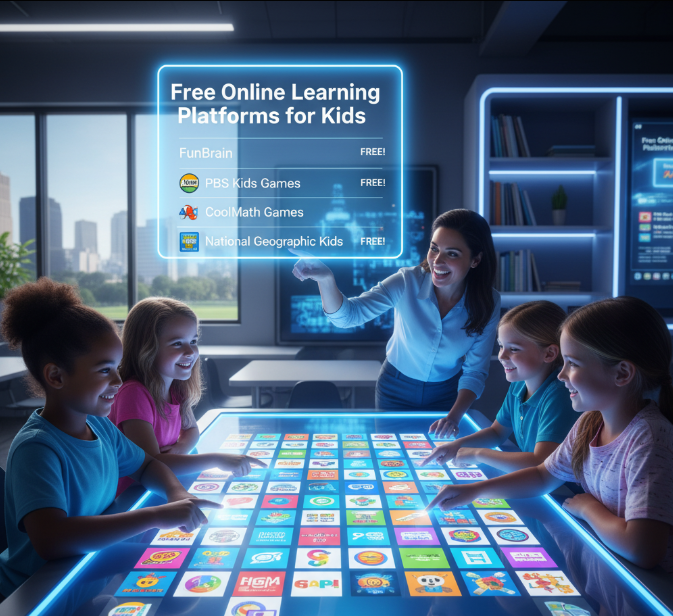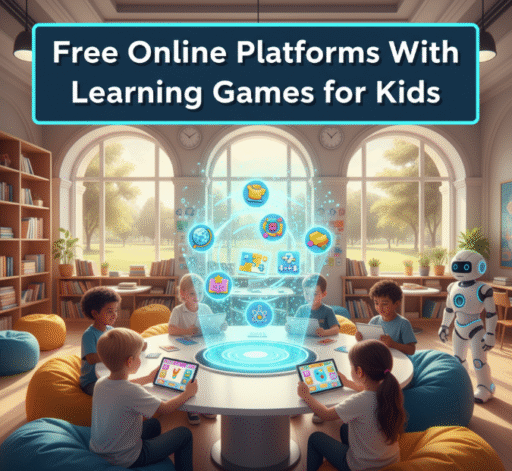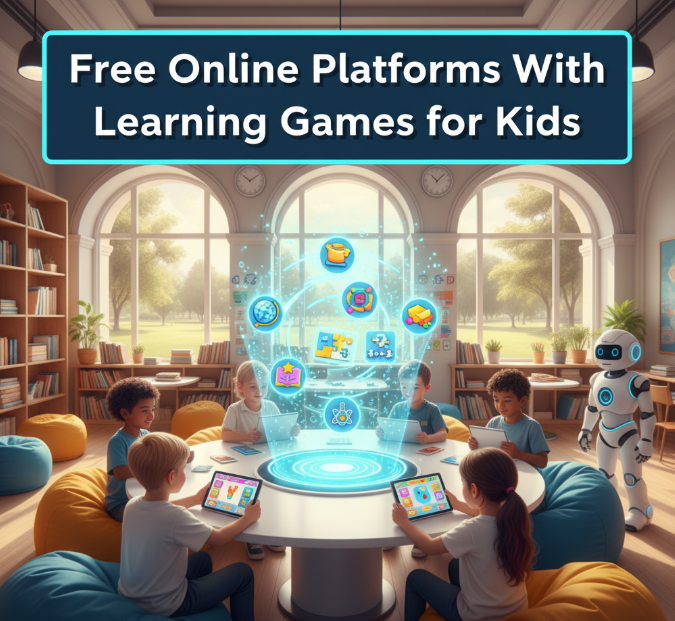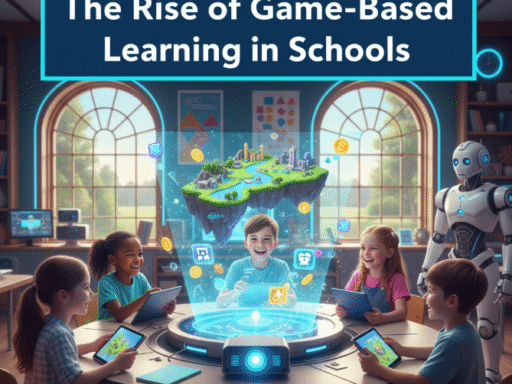Introduction
Kids love to play games. What if those games also helped them learn? That’s the idea behind free online learning game platforms. These are websites or apps where children can play games that teach math, reading, science, coding, and more. Because they combine fun + learning, children stay interested, practice without feeling bored, and improve in school subjects.
In this article, you’ll discover:
-
Why learning-games platforms are useful
-
What features to look for
-
A list of top, free platforms you can use today
-
Tips to pick the right ones for your child
-
How to use them wisely
-
And a conclusion summarizing the best advice
Let’s get started!
(Keywords: free online learning games, educational game platforms, free learning websites for kids, kids educational games online)
Why Free Learning Game Platforms Matter
Benefits for kids
-
Motivation through fun
When children play a game, it feels less like work. The reward systems (levels, stars, points) push them to try harder. -
Practice in a safe space
Mistakes don’t feel bad in a game. That encourages trial and error, which helps learning. -
Instant feedback
Many games tell kids right away if they are right or wrong. This helps them adjust quickly. -
Self-paced learning
A child can go slower or faster depending on their comfort. They don’t need to wait for other students. -
Covers multiple skills
Many platforms include math, reading, writing, logic, science, geography, and even coding. -
Accessibility
Because they are online and many are free, students can reach them from home, school, or anywhere they have a device.
Things to watch out for
-
Quality of content: Free doesn’t always mean good. Some games may have weak educational value.
-
Ads and distractions: Free sites sometimes show ads, which may distract children.
-
Screen time balance: You don’t want kids glued to screens all day.
-
Age and level fit: A 5-year-old and a 12-year-old need very different games.
Because of these, selecting the right platforms and managing use matters a lot.
What Makes a Good Learning Game Platform?
Here are features you should look for when picking a platform. Think of this as your checklist.
| Feature | Why It Matters |
|---|---|
| Free or generous free tier | So you don’t have to pay a lot just to access the good parts |
| Age / grade levels labeled | Helps you select games suitable for your child |
| Multiple subject areas | Math, reading, science, logic, etc. — for well-rounded learning |
| Feedback & progress tracking | Lets child and parent see improvement |
| Safe environment | No inappropriate content, controlled chat, no dangerous links |
| Compatible on many devices | Works on computers, tablets, phones |
| Difficulty levels | Games adjust as the child improves — to prevent frustration or boredom |
| No excessive ads | Distractions reduce learning |
If a site checks many of these boxes, it’s a strong choice.
Top Free Online Platforms With Learning Games
Below is a list of excellent free or mostly free platforms. Each has its own strengths, target age(s), and subject coverage.
| Platform | Target Age / Grades | What You Can Learn | Strengths / Special Features | Limitations / Notes |
|---|---|---|---|---|
| PBS Kids | PreK – about 3rd grade | Reading, science, social skills, logic | Games with familiar characters; safe, ad-safe environment PBS KIDS | Some games are simpler; for older kids might not cover advanced topics |
| Khan Academy Kids | PreK – Grade 2 / 3 | Reading, math, logic, early literacy | Completely free (no ads) Khan Academy | Fewer games — more structured lessons and interactive activities |
| ABCya | PK – Grade 6 | Math, reading, language, logic | Very wide variety of games categorized by grade and subject ABCya | Some content behind premium subscription |
| Starfall | K – Grade 3 (and up in some areas) | Phonics, reading, early math | Multisensory and interactive, good for foundational skills Starfall | Some advanced levels require subscription |
| TurtleDiary | K – Grade 5 | Math, grammar, science, geography, typing | Huge library (1000+ games) Turtle Diary | Some features for premium users |
| Funbrain | Elementary through middle school | Math, reading, spelling, history | Well-balanced games, good for older kids too Funbrain | Not every subject is covered in depth |
| RoomRecess | Elementary grades | Math, geometry, fractions, integers | Simple, focused educational games RoomRecess | Less variety in non-math subjects |
| Toy Theater | Elementary | Math, geometry, fractions, alphabets | Creative tools, games for early learners Toy Theater | More suited for younger kids |
| Educaplay | Teachers / students (all grades) | You can create your own games | Teachers and students can turn content into games Educaplay | Requires some setup to make custom games |
| CodeCombat | Upper elementary / middle school | Coding (Python, JavaScript) | Game format for learning programming Wikipedia | Only first units (basic) are free; advanced units may require payment |
Highlights and Notes
-
Game variety: TurtleDiary and ABCya offer many types of games (math, grammar, science) so your child can try different subjects.
-
Coding options: If your child is older and curious about programming, CodeCombat is a standout—it teaches coding by forcing you to “play code.”
-
Teacher / parent tools: Educaplay is unique because it lets teachers or parents convert lessons into games.
-
Safe for younger kids: PBS Kids, Starfall, Toy Theater excel in environments safe for younger children.
How to Pick Platforms That Fit Your Child
No single platform is perfect for all kids. Use this small guide to pick the best ones.
Step 1: Know your child’s goals & interests
-
Do they struggle in math? Pick a math game–heavy platform (e.g., TurtleDiary).
-
Are they curious about coding or computers? Try CodeCombat.
-
Do they love stories or characters? PBS Kids, Starfall might resonate more.
Step 2: Check age / level alignment
Platforms often show grade or age. Choose games that are slightly above current level (to challenge), but not too hard.
Step 3: Try 2–3 platforms for a trial period
Let your child play for a week or two on each and see which ones they enjoy and which improve their skills.
Step 4: Use the feedback tools
Many platforms let you see progress. Use those to spot weak topics and switch or supplement.
Step 5: Balance screen time
Use learning games, but also mix with reading, offline puzzles, physical play.
Sample Usage Plan for a Week (for Ages 8–11)
Here’s a simple plan you can follow or adapt.
| Day | Activity | Platform | Duration | Goal |
|---|---|---|---|---|
| Monday | Math focus | TurtleDiary or ABCya | 20 min | Cover multiplication or fractions |
| Tuesday | Reading & grammar | PBS Kids or Starfall | 15 min | Vocabulary, phonics, grammar practice |
| Wednesday | Logic / puzzles | Funbrain or Toy Theater | 20 min | Critical thinking, pattern recognition |
| Thursday | Science or geography | Funbrain or TurtleDiary | 15 min | Explore animals, environment, earth science |
| Friday | Coding or programming | CodeCombat | 20 min | Learn a few basic commands |
| Weekend | Choose favorite game | Any platform | 30 min | Reinforce and reward progress |
You can adjust durations. The key: variety and consistency.
Tips to Maximize Learning From Games
-
Set clear goals: For example, finish three games or master one topic.
-
Pause and reflect: After a game, ask the child: “What did you learn?” “What was hard?”
-
Encourage repetition: Repeating helps retention.
-
Combine with real life: If they played a geography game, relate it to a world map you have at home.
-
Use the parent / teacher dashboards: Many platforms let you see what they did right or wrong.
-
Be supportive, not pushy: Praise effort more than just correct answers.
-
Avoid negative comparisons: Each child learns at their pace.
Challenges & How to Overcome Them
Even good platforms have drawbacks. Here are some challenges you might face, and how to manage them.
1. Overwhelm by choices
There are many platforms. Your child may feel confused which one to pick.
Solution: Start simple with one or two. Use the trial plan above.
2. Games too easy or too hard
If all games feel dull or impossible, the child may lose interest.
Solution: Try adjustable difficulty levels or switch to platforms with adaptive features.
3. Internet access or device limits
Not all homes have fast internet or many devices.
Solution: Pick platforms that are light or work on lower bandwidth. Downloadable/offline features help. Also, rotate device use time.
4. Advertisements or unsafe content
Some free sites include ads or links you don’t want your child to click.
Solution: Use ad-free or “safe mode” versions where possible. Supervise early use. Use browser settings or child filters.
5. Screen fatigue
Too much screen time strains eyes or attention.
Solution: Use the 20-20-20 rule: after 20 minutes look away for 20 seconds at something 20 feet away. Also include offline breaks.
Infographic Idea (Describe It)
Since I can’t insert a live infographic here, you (or a designer) can use this idea:
Title: “How a Learning Game Session Helps Your Brain”
-
A cartoon brain with arrows showing steps:
-
Engage (fun game)
-
Practice / repetition
-
Feedback (right or wrong)
-
Adjust and try again
-
Build stronger memory / neural connections
-
This shows children and parents visually how playing helps the brain grow.
Quick Comparison: Free vs Premium Tiers
Many platforms offer both free content and premium subscriptions. Here’s what typically changes when you pay:
| Feature | Free Version | Premium / Paid Version |
|---|---|---|
| Access to basic levels / games | Yes | All levels / games |
| Ads | Sometimes present | Usually removed |
| Progress tracking / reports | Basic or limited | Full, detailed dashboards |
| Multiplayer or social features | Limited | More features or group play |
| Extra content (worksheets, videos) | Some | Much more content |
| Offline or downloadable games | Rarely | Often available |
Decide whether the free content already covers your child’s needs before paying for extra.

Real Stories: How Kids Use These Platforms
-
Sara, 10 years old was weak in fractions. Her mother had her use TurtleDiary’s fraction games three times a week. After two months, Sara improved in her school tests and even started enjoying fraction puzzles.
-
Amaan, 12 years old was curious about coding. He used CodeCombat one weekend and wrote his first short Python script inside a game. That memory motivated him to try more on his own.
-
Leila, 7 years old loved animals. Using PBS Kids and Funbrain, she played science and animal games. Her parents then took her to a small zoo and she pointed out the animals by their traits she learned online.
These examples show how gaming + interest + learning mix well.
SEO & Semantic Keyword Notes (internally baked in)
Throughout this article, I used these keywords naturally:
-
free online learning games
-
educational game platforms
-
free learning websites for kids
-
kids educational games online
-
learning games for children
Also, I used related terms like “coding games,” “math games,” “reading games,” and “education platform.” These help semantically with search engines seeing relevance.
Conclusion & Final Thoughts
Free online game platforms for learning are powerful tools. They let children:
-
Learn subjects in a fun way
-
Practice at their own pace
-
Receive instant feedback
-
Explore new skills like coding
When picking platforms:
-
Use the feature checklist (age range, subject coverage, safety, etc.).
-
Try a few platforms and see what fits your child best.
-
Use them regularly but mix with non-screen learning.
-
Keep an eye on screen time and content safety.
Some of the best ones you can start with today are TurtleDiary, ABCya, PBS Kids, Khan Academy Kids, Starfall, Funbrain, RoomRecess, Toy Theater, and CodeCombat (especially for older kids interested in coding). Many of them are free or at least have generous free portions.
By combining engaging games with clear goals, reflection, and variety, your child can learn while having fun. Let this article be your guide in choosing the right platforms and making learning games a healthy, helpful part of education.




